Aristolochia
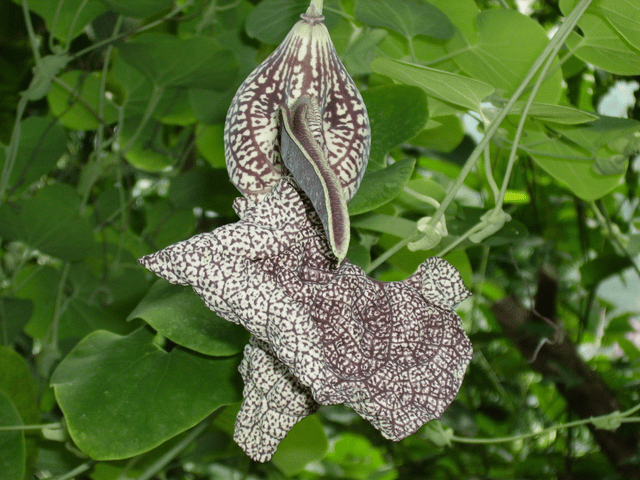
Aristolochia

| Aristolochia | |
|---|---|
| Aristolochia labiata | |
| Scientific classification | |
| Kingdom: | Plantae |
| Clade: | Angiosperms |
| Clade: | Magnoliids |
| Order: | Piperales |
| Family: | Aristolochiaceae |
| Subfamily: | Aristolochioideae |
| Genus: | Aristolochia L.[1] |
| Species | |
| Over 500, see text | |
| Synonyms | |
| Hocquartia Dum. Holostylis Duch., Ann. Sci. Nat., Bot. sér. 4, 2: 33, t. 5. 1854. Isotrema Raf. (disputed) | |
Aristolochia (English: /əˌrɪstəˈloʊkiə/) is a large plant genus with over 500 species that is the type genus of the family Aristolochiaceae. Its members are commonly known as birthwort, pipevine or Dutchman's pipe and are widespread and occur in the most diverse climates. Some species, like A. utriformis and A. westlandii, are threatened with extinction.
Isotrema is usually included here, but might be a valid genus. If so, it contains those species with a three-lobed calyx.
| Aristolochia | |
|---|---|
| Aristolochia labiata | |
| Scientific classification | |
| Kingdom: | Plantae |
| Clade: | Angiosperms |
| Clade: | Magnoliids |
| Order: | Piperales |
| Family: | Aristolochiaceae |
| Subfamily: | Aristolochioideae |
| Genus: | Aristolochia L.[1] |
| Species | |
| Over 500, see text | |
| Synonyms | |
| Hocquartia Dum. Holostylis Duch., Ann. Sci. Nat., Bot. sér. 4, 2: 33, t. 5. 1854. Isotrema Raf. (disputed) | |
Description
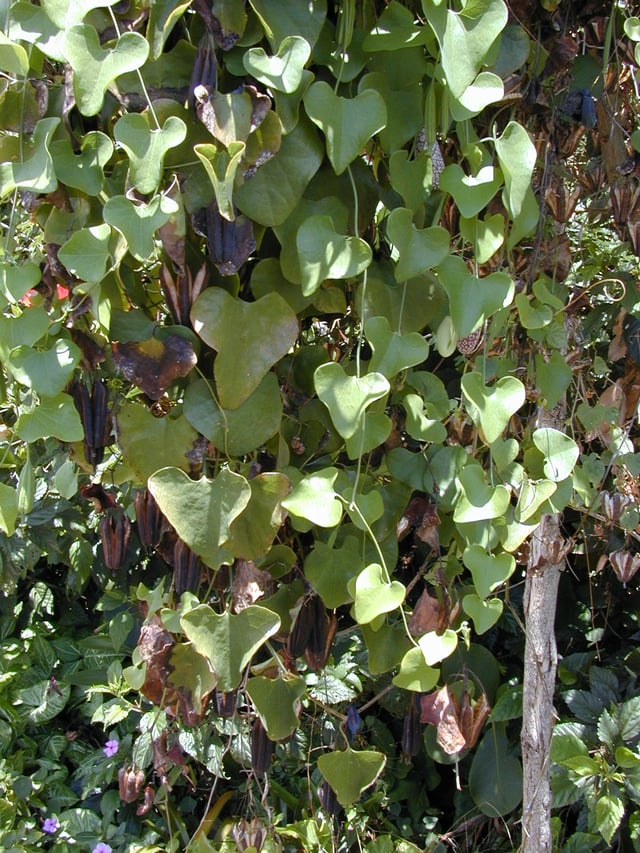
Calico flower (A. littoralis): habit

Aristolochic acid, the main toxin of pipevines
Aristolochia is a genus of evergreen and deciduous lianas (woody vines) and herbaceous perennials. The smooth stem is erect or somewhat twining. The simple leaves are alternate and cordate, membranous, growing on leaf stalks. There are no stipules.
The flowers grow in the leaf axils. They are inflated and globose at the base, continuing as a long perianth tube, ending in a tongue-shaped, brightly colored lobe. There is no corolla. The calyx is one to three whorled, and three to six toothed. The sepals are united (gamosepalous). There are six to 40 stamens in one whorl. They are united with the style, forming a gynostemium. The ovary is inferior and is four to six locular.
These flowers have a specialized pollination mechanism. The plants are aromatic and their strong scent[2] attracts insects. The inner part of the perianth tube is covered with hairs, acting as a fly-trap. These hairs then wither to release the fly, covered with pollen.
The fruit is dehiscent capsule with many endospermic seeds.
The common names Dutchman's pipe and pipevine (e.g. common pipevine, A. durior) are an allusion to old-fashioned meerschaum pipes at one time common in the Netherlands and northern Germany. Birthwort (e.g. European birthwort A. clematitis) refers to these species' flower shape, resembling a birth canal. Aristolochia was first described by the 4th c. BC Greek philosopher and botanist Theophrastos in his book [Inquiry of Plants, IX.8.3], and the scientific name Aristolochia was developed from Ancient Greek aristos (άριστος) "best" + locheia (λοχεία), childbirth or childbed, relating to its known ancient use in childbirth.[3][4] The Roman orator Cicero records a different tradition, that the plant was named for the otherwise unknown individual with the common Greek name Aristolochos, who had learned from a dream that it was an antidote for snake bites.[5]
Herbalism, toxicity and carcinogenicity
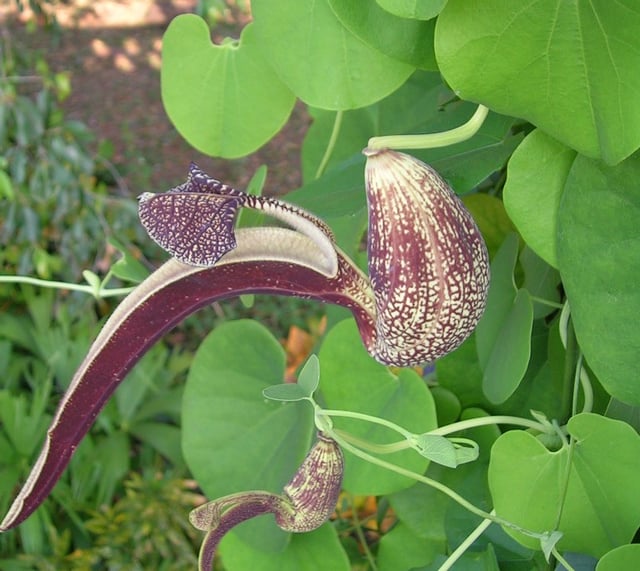
Ornamental Aristolochia ringens
The species Aristolochia clematitis was highly regarded as a medicinal plant since the ancient Egyptians, Greeks and Romans, and on to until the Early Modern era; it also plays a role in traditional Chinese medicine. Due to its resemblance to the uterus, the doctrine of signatures held that birthwort was useful in childbirth. A preparation was given to women upon delivery to expel the placenta, as noted by the herbalist Dioscurides in the 1st century AD. Despite its presence in ancient medicine, Aristolochia is known to contain the lethal toxin aristolochic acid.
The Bencao Gangmu, compiled by Li Shi-Zhen in the latter part of the sixteenth century, was based on the author’s experience and on data obtained from earlier herbals; this Chinese herbal classic describes 1892 "drugs" (with 1110 drawings), including many species of Aristolochia.[6] For 400 years, the Bencao Gangmu remained the principal source of information in traditional Chinese medicine and the work was translated into numerous languages, reflecting its influence in countries other than China. In the mid-twentieth century, the Bencao Gangmu was replaced by modern Materia Medica, the most comprehensive source being Zhong Hua Ben Cao (Encyclopedia of Chinese Materia Medica), published in 1999.[7] The Encyclopedia lists 23 species of Aristolochia, though with little mention of toxicity. The Chinese government currently lists the following Aristolochia herbs: A. manshuriensis (stems), A. fangchi (root), A. debilis (root and fruit), and A. contorta (fruit), two of which (madouling and qingmuxiang) appear in the 2005 Pharmacopoeia of the People's Republic of China.
Despite the toxic properties of aristolochic acid, naturopaths claim that a decoction of birthwort stimulates the production and increases the activity of white blood cells,[11] or that pipevines contain a disinfectant which assists in wound healing.[12] Also, Aristolochia bracteolata is colloquially known as "worm killer" due to supposed antihelminthic activity.[13]
Aristolochia taxa have also been used as reptile repellents. A. serpentaria (Virginia snakeroot) is thus named because the root was used to treat snakebite, as "so offensive to these reptiles, that they not only avoid the places where it grows, but even flee from the traveler who carries a piece of it in his hand".[14] A. pfeiferi,[15] A. rugosa,[16] and A. trilobata[17] are also used in folk medicine to treat snakebites.
Toxicity and carcinogenicity
In 1993, a series of end-stage renal disease cases was reported[9][18] from Belgium associated with a weight loss treatment, where Stephania tetrandra in a herbal preparation was suspected of being substituted with Aristolochia fangchi.[19][20] More than 105 patients were identified with nephropathy following the ingestion of this preparation from the same clinic from 1990 to 1992. Many required renal transplantation or dialysis.[21]
Aristolochia has been shown to be both a potent carcinogen and kidney toxin. Herbal compounds containing Aristolochia are classified as a Group 1 carcinogen by the International Agency for Research on Cancer.[22] Epidemiological and laboratory studies have identified Aristolochia to be a dangerous kidney toxin; Aristolochia has been shown associated with more than 100 cases of kidney failure.[23] Furthermore, it appears as if contamination of grain with European birthwort (A. clematitis) is a cause of Balkan nephropathy, a severe renal disease occurring in parts of southeast Europe.[24]
Aristolochic acid was linked to aristolochic acid-associated urothelial cancer in a Taiwanese study in 2012.[25] In 2013, two studies reported that aristolochic acid is a strong carcinogen. Whole-genome and exome analysis of individuals with a known exposure to aristolochic acid revealed a higher rate of somatic mutation in DNA.[26][27] Metabolites of aristolochic acid enter the cell nucleus and form adducts on DNA. While adducts on the transcribed DNA strand within genes are detected and removed by transcription-coupled repair, the adducts on the non-transcribed strand remain and eventually cause DNA replication errors. These adducts have a preference for adenine bases, and cause A-to-T transversions. Furthermore, these metabolites appear to show a preference for CAG and TAG sequences.
Garden history
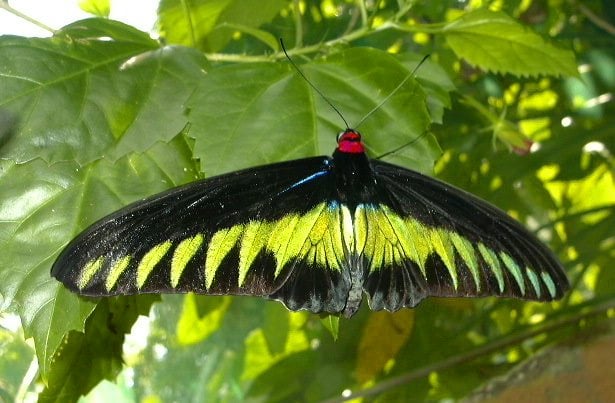
Rajah Brooke's birdwing: its caterpillars feed on Aristolochia foveolata
Due to their spectacular flowers, several species are used as ornamental plants, notably the hardy A. durior of eastern North America, which was one of John Bartram's many introductions to British gardens; in 1761 Bartram sent seeds he had collected in the Ohio River Valley to Peter Collinson in London, and Collinson gave them to the nurseryman James Gordon at Mile End to raise. The vine was soon adopted for creating for arbors "a canopy impenetrable to the rays of the sun, or moderate rain," as Dr John Sims noted in The Botanical Magazine, 1801.[28]
Swallowtail butterflies
Many species of Aristolochia are eaten by the caterpillar larvae of swallowtail butterflies, thus making themselves unpalatable to most predators. Lepidoptera feeding on pipevines include:
Choreutidae
Millieria leaf miner
Papilionidae
False Apollo (Archon apollinus) – known from numerous pipevine species
Bhutanitis Bhutan glory (B. lidderdalii) – known from A. griffithi, A. kaempferii, A. mandshuriensis and maybe others[29][30] Chinese three-tailed swallowtail (B. thaidina) – known from A. moupinensis
Troidini Great windmill (Atrophaneura dasarada) – only known from A. griffithi Common batwing (Atrophaneura varuna) – only known from A. kaempferi Troides plateni – only known from Indian birthwort (A. tagala) Cairns birdwing (Ornithoptera euphorion) Richmond birdwing (O. richmondia) Paradise birdwing (O. paradisea) Rajah Brooke's birdwing (Trogonoptera brookiana) – only known from A. foveolata Magellan birdwing (T. magellanus) – known on A. cucurbitifolia, A. ovatifolia, A. zollingeriana and maybe others Pipevine swallowtail (Battus philenor) – known on A. macrophylla, Virginia snakeroot (A. serpentaria) and others
In Australia the invasive Aristolochia littoralis is fatal to the caterpillars of Ornithoptera euphorion and O. richmondia and threatens to displace their proper host, A. tagala.
Selected species
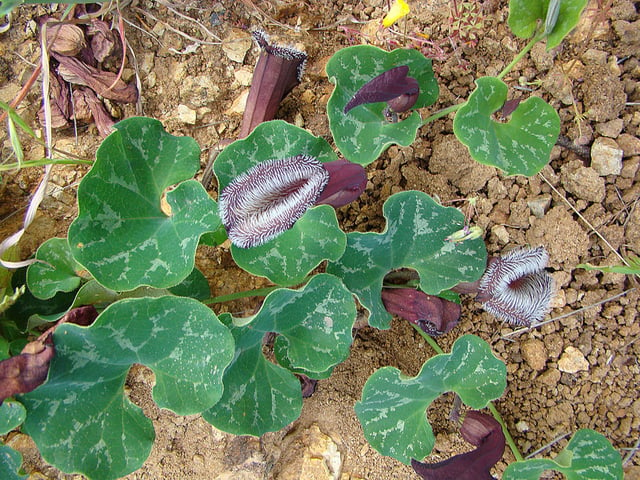
Aristolochia chilensis
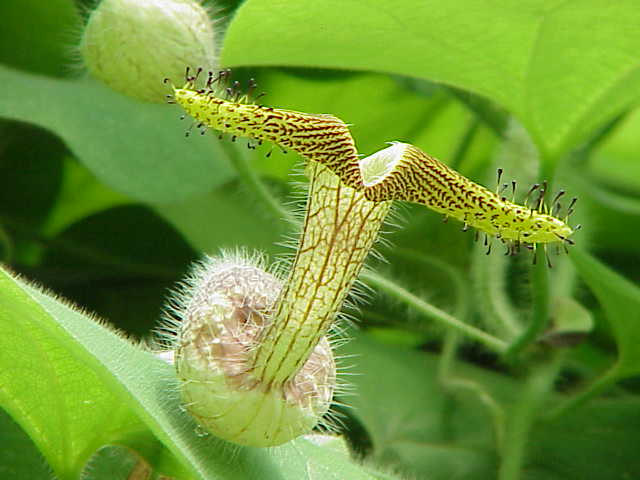
Aristolochia eriantha
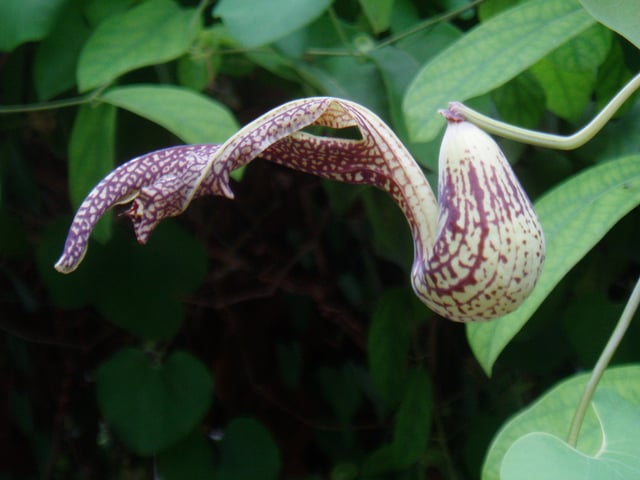
Aristolochia gibertii
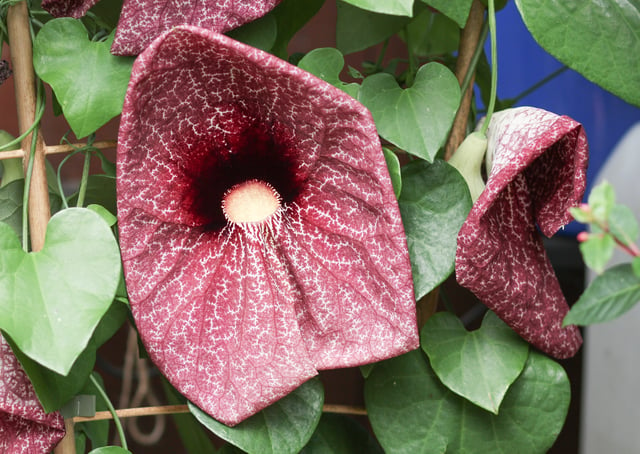
Aristolochia grandiflora
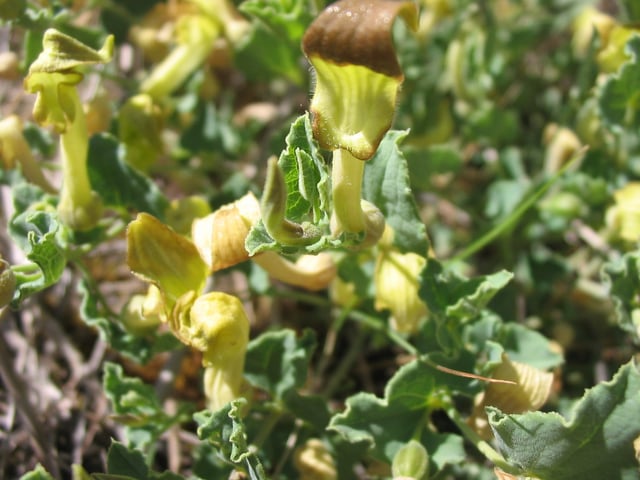
Aristolochia pistolochia
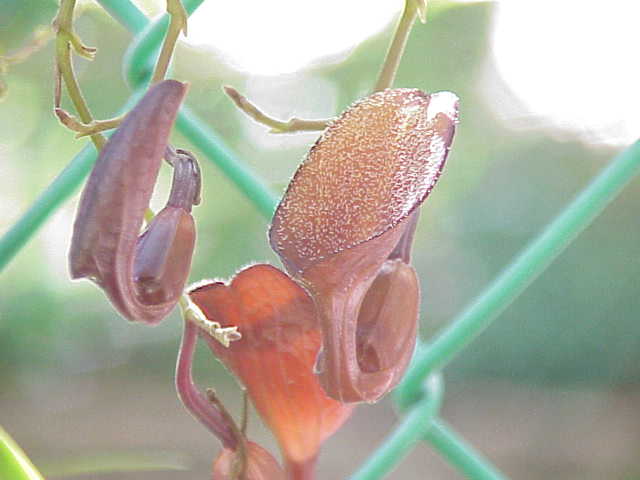
Aristolochia maxima
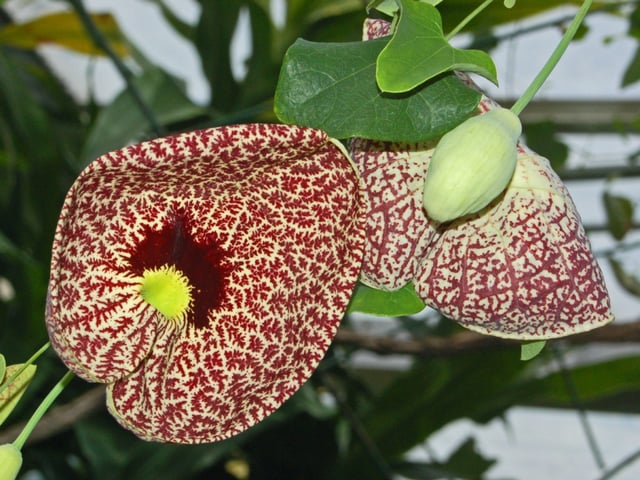
Aristolochia littoralis
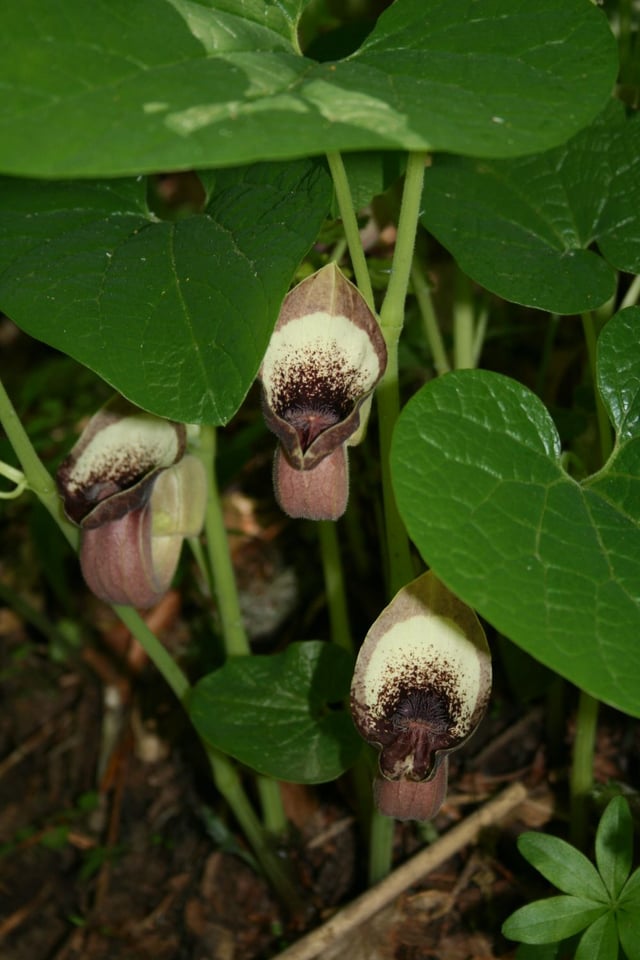
Aristolochia pontica
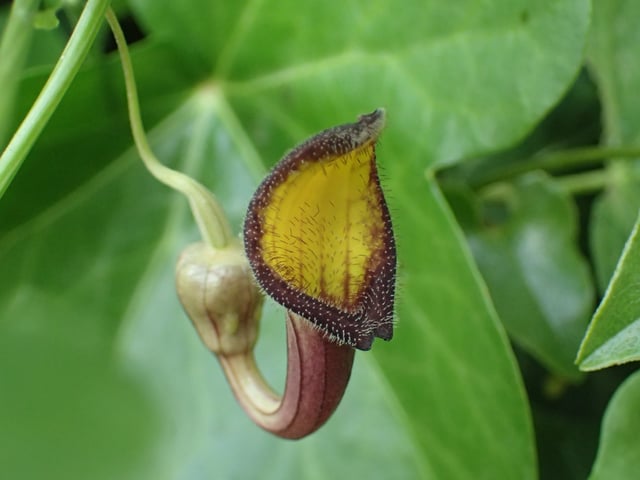
Aristolochia sempervirens
Aristolochia acuminata Lam. [[INLINE_IMAGE|//upload.wikimedia.org/wikipedia/commons/thumb/f/ff/Aristolochia_acuminata_Blanco1.104.png/220px-Aristolochia_acuminata_Blanco1.104.png|//upload.wikimedia.org/wikipedia/commons/thumb/f/ff/Aristolochia_acuminata_Blanco1.104.png/330px-Aristolochia_acuminata_Blanco1.104.png 1.5x, //upload.wikimedia.org/wikipedia/commons/thumb/f/ff/Aristolochia_acuminata_Blanco1.104.png/440px-Aristolochia_acuminata_Blanco1.104.png 2x||h320|w220|thumbimage]] Aristolochia acuminata habitus drawing
Aristolochia acutifolia
Aristolochia allemanii
Aristolochia anguicida Jacq. – harlequin Dutchman's pipe
Aristolochia arborea [[INLINE_IMAGE|//upload.wikimedia.org/wikipedia/commons/thumb/2/26/Aristolochoia_arborea0.jpg/220px-Aristolochoia_arborea0.jpg|//upload.wikimedia.org/wikipedia/commons/thumb/2/26/Aristolochoia_arborea0.jpg/330px-Aristolochoia_arborea0.jpg 1.5x, //upload.wikimedia.org/wikipedia/commons/thumb/2/26/Aristolochoia_arborea0.jpg/440px-Aristolochoia_arborea0.jpg 2x||h165|w220|thumbimage]] Aristolochia arborea flowers
Aristolochia arcuata Mast.
Aristolochia auricularia
Aristolochia baetica
Aristolochia bilabiata L. – West Indian Dutchman's pipe
Aristolochia billardieri
Aristolochia bilobata – two-lobed Dutchman's pipe
Aristolochia bodamae
Aristolochia boosii
Aristolochia bottae
Aristolochia bracteolata Lam. – worm killer
Aristolochia bridgesii – Chilean yellow fox's ears
Aristolochia burelae
Aristolochia californica Torr. – California pipevine, California Dutchman's pipe
Aristolochia cauliflora Ule
Aristolochia caudata
Aristolochia chachapoyensis
Aristolochia chapmaniana (= A. tonduzii)
Aristolochia chilensis Bridges ex Lindl. – Chilean fox's ears
Aristolochia chrismulleriana[31]
Aristolochia clematitis L. – European birthwort
Aristolochia colossifolia – giant-leaved aristolochia
Aristolochia constricta
Aristolochia contorta
Aristolochia cordiflora
Aristolochia cordigera
Aristolochia cornuta
Aristolochia coryi I.M.Johnst – Cory's Dutchman's pipe
Aristolochia cucurbitifolia Hayata
Aristolochia cucurbitoides C.F.Liang
Aristolochia cymbifera Mart.
Aristolochia daemoninoxia
Aristolochia dalyi
Aristolochia delavayi Franch.
Aristolochia deltantha
Aristolochia deltoidea
Aristolochia didyma – yawar panga
Aristolochia durior (= A. macrophylla) – common Dutchman's pipe, common pipevine
Aristolochia erecta – swanflower
Aristolochia eriantha
Aristolochia esperanzae Kuntze
Aristolochia fangchi Y.C.Wu ex L.D.Chow & S.M.Hwang
Aristolochia filipendulina
Aristolochia fimbriata – white-veined Dutchman's pipe
Aristolochia foetida – Jalisco Dutchman's pipe
Aristolochia foveolata
Aristolochia galeata
Aristolochia gibertii
Aristolochia gigantea Mart. – giant pelican flower, Brazilian Dutchman's pipe
Aristolochia glandulosa J.Kickx f. – Cuban birthwort
Aristolochia gorgona
Aristolochia grandiflora Sw. – pelican flower
Aristolochia griffithi
Aristolochia guentheri
Aristolochia hainanensis Merr.
Aristolochia hians
Aristolochia hirta
Aristolochia holtzei
Aristolochia indica L.
Aristolochia inflata
Aristolochia iquitensis
Aristolochia islandica
Aristolochia kaempferi Willd.
Aristolochia kewensis
Aristolochia klugii – moth-winged birthwort
Aristolochia labiata Willd. – mottled Dutchman's pipe, rooster flower
Aristolochia leuconeura
Aristolochia lindneri [[INLINE_IMAGE|//upload.wikimedia.org/wikipedia/commons/thumb/f/f0/Aristolochia_lindneri6.jpg/220px-Aristolochia_lindneri6.jpg|//upload.wikimedia.org/wikipedia/commons/thumb/f/f0/Aristolochia_lindneri6.jpg/330px-Aristolochia_lindneri6.jpg 1.5x, //upload.wikimedia.org/wikipedia/commons/thumb/f/f0/Aristolochia_lindneri6.jpg/440px-Aristolochia_lindneri6.jpg 2x||h165|w220|thumbimage]] Aristolochia lindneri
Aristolochia lingulata
Aristolochia littoralis D.Parodi – elegant Dutchman's pipe, calico flower
Aristolochia longa – long aristolochia, sarrasine
Aristolochia macrophylla Lam. [[INLINE_IMAGE|//upload.wikimedia.org/wikipedia/commons/thumb/1/13/Aristolochia_macrophylla_on_tree.jpg/220px-Aristolochia_macrophylla_on_tree.jpg|//upload.wikimedia.org/wikipedia/commons/thumb/1/13/Aristolochia_macrophylla_on_tree.jpg/330px-Aristolochia_macrophylla_on_tree.jpg 1.5x, //upload.wikimedia.org/wikipedia/commons/thumb/1/13/Aristolochia_macrophylla_on_tree.jpg/440px-Aristolochia_macrophylla_on_tree.jpg 2x||h293|w220|thumbimage]] Aristolochia macrophylla
Aristolochia macroura
Aristolochia manchuriensis
Aristolochia mathewsii
Aristolochia maurorum
Aristolochia maxima Jacq. – Florida Dutchman's pipe
Aristolochia moupinensis
Aristolochia nana – tiny pelican flower
Aristolochia obliqua S.M.Hwang
Aristolochia odoratissima L. – fragrant Dutchman's pipe
Aristolochia orbicularis
Aristolochia ornithocephala – bird's head pipevine
Aristolochia ovalifolia
Aristolochia paecilantha
Aristolochia pallida
Aristolochia parviflora
Aristolochia paulistana Hoehne
Aristolochia peltata L. – peltate Dutchman's pipe
Aristolochia pentandra Jacq. – Marsh's Dutchman's pipe
Aristolochia pfeiferi – dubsangid (Kuna language)
Aristolochia pilosa
Aristolochia pistolochia L.
Aristolochia poecilantha
Aristolochia pontica
Aristolochia prostrata
Aristolochia pubera
Aristolochia quangbinhensis
Aristolochia raja
Aristolochia reticulata Jacq. – Red River snakeroot, Texas Dutchman's pipe
Aristolochia ridicula N.E.Br.
Aristolochia ringens Vahl – gaping Dutchman's pipe
Aristolochia rotunda L. – smearwort, round birthwort, English mercury, mercury goosefoot, allgood, tola bona, fat hen – type species
Aristolochia rugosa Lam. – mat root (Trinidad and Tobago)
Aristolochia salvadorensis Aristolochia salvadorensis platensis
Aristolochia schippii
Aristolochia scytophylla S.M.Hwang & D.L.Chen
Aristolochia sempervirens L.
Aristolochia serpentaria L. – Virginia snakeroot
Aristolochia silvatica
Aristolochia sipho L'Hér.
Aristolochia socorroensis
Aristolochia sprucei – spruce-leaved aristolochia
*Aristolochia stevensii * Barringer
Aristolochia stomachoides
Aristolochia surinamensis Willd.
Aristolochia tagala – Indian birthwort
Aristolochia taliscana
Aristolochia tentaculata
Aristolochia thozetii
Aristolochia thwaitesii Hook
Aristolochia tomentosa Sims – woolly pipevine, woolly Dutchman's pipe
Aristolochia tricaudata
Aristolochia trilobata – bejuco de Santiago (Trinidad and Tobago)
Aristolochia tuberosa C.F.Liang & S.M.Hwang
Aristolochia urupaensis – heart-leaved aristolochia
Aristolochia utriformis S.M.Hwang
Aristolochia watsonii Woot. & Standl. – Watson's Dutchman's pipe
Aristolochia weddellii
Aristolochia westlandii Hemsl.
Aristolochia wrightii Seem.
Formerly placed here
Abuta amara (as Aristolochia amara)
Pararistolochia goldieana (Hook.f.) Hutch. & Dalziel (as A. goldieana Hook.f.)[32]
See also
Nepenthes aristolochioides, a carnivorous plant with pitchers resembling Aristolochia flowers
Opodeldoc